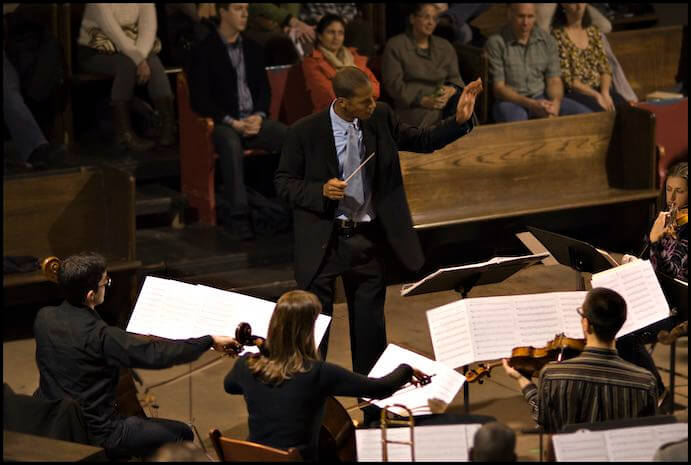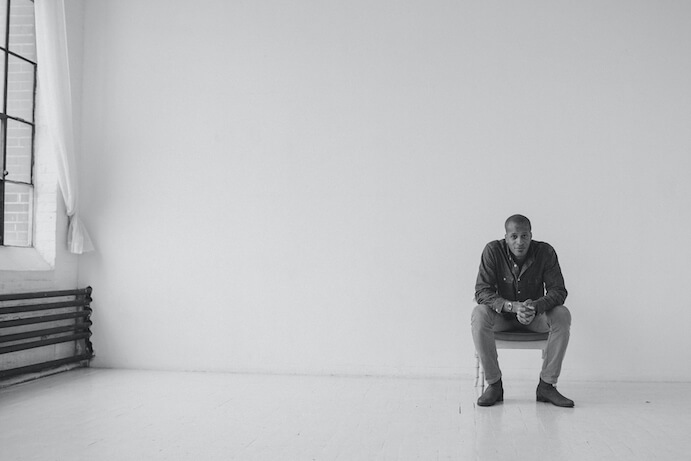Joseph C. Phillips Jr. is a composer who defines his own work as “mixed music,” a style that arranges a myriad of elements from different influences into a wholly unique product, not necessarily bound by the limits of traditional notation. Phillips founded the Numinous Ensemble in 2000, which boasts a flexible instrumentation of up to 30 players and has performed at venues such as Brooklyn Academy of Music and Le Poisson Rouge, while releasing recordings on New Amsterdam Records and innova Recordings. The Grey Land, Phillips’ newest opera released on New Amsterdam, is “a story of a Black mother trying to survive the reality in this land that doesn’t fully see her continued hope.” Numinous also just announced the first iteration of The Numinous Initiative, a project to perform and record the music of six emerging Black composers, and they are accepting applications through December 20, 2020.
Your new opera, The Grey Land, uses a nontraditional score. How do modes of musical expression outside of traditional notation enhance the story and themes of The Grey Land (or opera in general)?
The score to The Grey Land is a traditionally-notated score except for a few instances such as Scene 3, “Tender Sorrow,” where the small ensemble and the cello solo for Mariel Roberts are temporally moving at different paces; an instance of guided improvisation in the ensemble in Scene 2, “Ferguson: Summer of 2014;” and the six-voice choir at the end of Scene 12, “The Sunken Place,” which is improvising over a static harmonic vocal pad while the ensemble is again temporally displaced. These aleatoric moments are another method adding emotional texture to enhance the mood, feeling, or meaning behind the words or music within those places in the score. While this is nothing different from how many other contemporary classical composers use similar methods, it really is in the concept and structure of the opera itself that uses its untraditional nature to combine broad and diverse scenes to gradually build into the photographic tapestry of a life—and how a Black family’s pain, joy, struggle, and success represents a shared societal commonality and humanity, rather than the frequent stereotypes and characterizations of ‘other.’
You’ve coined your compositions as “mixed music–an organic fusing of various elements from many different influences forming compositions that are personal, different, and new.” I’m curious about how far this term extends to your practice as a musician. Does this refer to only the blending of stylistic concerns, or perhaps also to the presentation of narrative in theatrical works, or something else entirely?
I originally thought about ‘mixed music’ as only a fusing of styles or genres into one singular musical vision. Through my subsequent work on my operas, however, I’ve come to see that that term of ‘mixed’ could be applied more broadly, for example with the librettos. The Grey Land blends texts from various sources, including my own original text, to create a single story/narrative. In Four Freedoms, the first two Acts use a variety of “found text,” while the last two Acts are newly-created poems that I wrote. And in the operas of my forthcoming 1619 cycle, there will be the concept of blending various voices and librettos into one larger narrative—perhaps it will be akin to the Marvel Cinematic Universe where different directors and visions all contribute to form a larger, single shared Universe. In the case of my operas, the one consistent through line, is me.
In what ways has the flexible instrumentation of Numinous presented new opportunities for you as a performer and composer, and in what ways has it presented restrictions?
The instrumentation of Numinous has never really presented me with any restrictions or limitations. I guess there’s always the practical matter of paying for it all, so the larger the ensemble/project, the more money I’ll need, and the more I have to gear myself up—financially and mentally—to how much money I will lose on any given project. But the flipside is that the opportunities Numinous has afforded me are almost boundless. Often I just think about what composition/project I’d like to do, think on the instrumentation I want to write for and what the project/composition will need (or what I want), and then I compose for that; all with the knowledge that I will have (or can find) the incredible musicians interested, willing, and able to play what I write.
At this point in our 20th year, many of the musicians of Numinous have been performing with me for a decade or longer, so an advantage is that during the conception of a particular composition, I will often have specific people in mind as I compose. So I am fortunate, and extremely grateful to the musicians who play with Numinous. And while it is hard work managing and maintaining a large ensemble, to know I have my own group performing my own music is something I dreamed about before I even moved to New York City, and something I never take for granted.

You recently announced The Numinous Initiative, which will perform and record the work of six emerging Black, African-American, or Black mixed composers. Do you feel that performers of contemporary music have a responsibility to work with emerging composers?
To go along with my answer to the previous question, I realize that I have this incredible resource with Numinous, and that today, many composers have fewer and fewer options to hear their music—especially if they don’t want to start their own ensemble, or don’t have connections, or if they want to write for an ensemble of larger and more variable forces than a string quartet or quintet. So I feel less a responsibility to perform the music of others—since Numinous will always remain a vehicle primarily to perform my music—and more of wanting to be someone who can advocate for other composers where I can, giving opportunities to have their large ensemble works performed by a top-flight ensemble.
Now, whether other classical music organizations have that same responsibility, I would say that they should not look at it as a responsibility or obligation or “taking a risk” to perform works from women or emerging composers or composers who are people of color, but rather an opportunity to champion music from perspectives less often showcased in classical music. And in so doing, they are helping to fulfill some of these organizations newly-found commitment (at least in their words) to programming more diverse voices—helping to enhance classical music’s viability and relevancy for old, new, and future listeners.

You are also starting work on an opera related to the 1619 Project. Can you tell us more about that and when we can expect to hear or see this work?
Actually it’s not one opera but a cycle of operas! Initially inspired by “The Case for Reparations” by Ta-Nehisi Coates and by the New York Times project, each opera in the cycle will reflect the predacity of American life—how this country “begins in Black plunder and white democracy, two features that are not contradictory but complementary” and how “virtually every institution with some degree of history in America, be it public, be it private, has a history of extracting wealth and resources out of the African-American community…that behind all of that oppression was actually theft.” But the operas will also highlight the very human stories of Black and Brown joy, love, and resiliency in the face of that oppression, as well as the larger systemic forces of class and power and wealth that affect all levels and people in our society. It’s been incredible reading, researching, and learning so much about all of the hidden or forgotten stories behind the development of this country, and I’m very excited about the cycle.
In mid-December I’ll be doing a public Zoom table read of one of the operas for the cycle I’ve just started working on, So Far Behind Now Because of Then. I’ve only written three scenes of the libretto (with no music composed so far), so this table read will be a testing out of some of the themes; since I’m still doing a lot of reading and research for the cycle, I’m assuming my plans for the cycle will undergo some changes. But right now, the plan is to have six one- to two-hour operas in the cycle, with each opera focusing on various eras from 1619 and into the future (for example So Far Behind Now Because of Then starts in the violence of the Red Summer of 1919 and goes into the 1950s/early 1960s). Like The Grey Land, the operas will feature film and dance choreography and, like the 1619 Project itself, hope to show a number of consistent themes through a series of wide-ranging historical fictional narratives that will reflect the story of America.
While I will write a couple of the librettos myself, I’ve also begun assembling a group of writers/poets who will also be writing librettos for specific operas in the cycle, as well. So far I have asked Kelley Rourke, Carl Hancock Rux, and Meshell Ndegeocello, and I hope to have their unique literary and artistic voices, meshing with my own, as we wrestle with the themes I’ve outlined to them for the cycle. At the end of the table read in December—which I’ll publish a link on my socials and website—I’m hoping to also have a short Q & A with the other writers where we would briefly discuss the opera cycle’s focus and goals. I hope to finish composing So Far Now Behind Because of Then by the end of 2021, and then we’ll see where the world is in terms of performance opportunities, so I can form a timeline for completing the other operas of the cycle.
I CARE IF YOU LISTEN is a program of the American Composers Forum, funded with generous donor and institutional support. A gift to ACF helps support the work of ICIYL. Editorial decisions are made at the sole discretion of the editor-in-chief. For more on ACF, visit the “At ACF” section or composersforum.org.
























